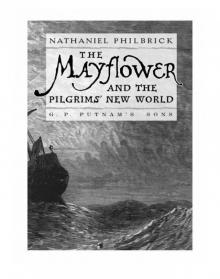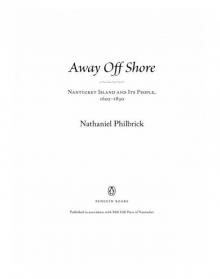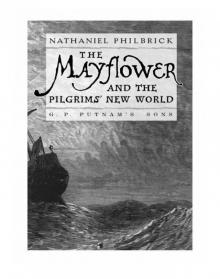- Home
- Nathaniel Philbrick
Away Off Shore: Nantucket Island and Its People, 1602-1890 Page 7
Away Off Shore: Nantucket Island and Its People, 1602-1890 Read online
Page 7
All possible local references aside, this is also an allusion to the Bible’s Book of Samuel, in which King Saul gathers “all the chief of the people” together so that he can determine who has sinned against him. Saul soon decides that Jonathan of Gibeah (who has just led the Hebrews against the Philistines) must die for breaking Saul’s proclamation against eating during the battle. As to be expected, the Hebrews immediately voice their objections: “And the people said unto Saul, Shall Jonathan die, who hath wrought this great salvation in Israel? God forbid. . . . So the people rescued Jonathan, that he died not.”
Adding to the possible similarity between this scene and what occurred on Nantucket in 1665 is that prior to the trial of Jonathan, Saul orders his people to “roll a great stone unto me this day.” The stone is later described as “the first altar that he built unto the LORD,” and it is here that Saul conducts the trial. Not far from where we know John Gibbs was initially apprehended is the boulder-topped hillside upon which this book began—Saul’s Hills and Altar Rock. Was this dramatic setting the staging ground for Philip’s Saul-like encounter with the English Nantucketers, and did Folger and his Bible-bred compatriots name the hill and rock accordingly? Even Assassamoogh’s English name of John Gibbs (which may have been awarded after the incident) may have first been inspired by the similarity between his situation and that of Saul’s son Jonathan of Gibeah.
There are other intriguing parallels between the biblical Saul and what we know of Philip on Nantucket, none of which are very flattering to the Indian sachem. When Saul is first chosen to be king of the Hebrews, Samuel leads the people in a loyalty oath: “And all the people shouted, and said, God save the king.” Of course, Philip also witnessed a loyalty oath while on Nantucket, during which a local Indian sachem proclaimed himself “subject to King Charles the Second.” The biblical portrait of Saul as a pathetic and tormented outcast king who ultimately dies ignominiously in battle—while it may not conform to our current tendency to see Philip as a doomed and valiant hero—probably corresponded very closely to the Nantucketers’ view of the man. Rather than stand up to a group of no more than thirty-five English men and boys, Philip had chosen—quite literally—to take the money and run. And, in point of fact, a stream flowing near where Philip’s war canoes are supposed to have landed is still referred to as “Philip’s Run,” a name that, according to island tradition, is a pun, once again, at Philip’s expense.
Clearly, then, the standoff with Philip in 1665 left an indelible mark on the island, but not only in terms of its place names. In “A Looking Glass” we see how it may have helped shape the islanders’ collective identity, contributing to a somewhat self-righteous sense of Nantucket’s being above the fray that was then engulfing the mainland. Philip—the supposed instrument of divine retribution according to many a Puritan sermon of the day—had been shown to be nothing more than a haughty and indecisive bully by Folger and his fellow Nantucketers. Indeed, behind his pleas for Christian charity and love, Folger displays a certain hubris in “A Looking Glass,” implying that his moral ground atop Altar Rock on Nantucket is higher than that of all New England’s Puritan divines put together.
But was this self-righteousness truly justified? Was Nantucket better than anywhere else when it came to English–Native American relations? To a certain extent, Nantucket in the seventeenth century had all the makings of an exemplary bi-cultural community: an isolated island with a tiny group of English surrounded by a large Native American population. But what might first seem like a veritable laboratory experiment for the advancement of interracial cooperation would ultimately create a community of an altogether different stamp.
The evidence reveals that once the English began to feel at least a measure of safety on Nantucket (a confidence that Folger’s poem exudes), a new dynamic started to operate. It was not just survival the English were after; they also wanted to prosper, and for that they needed workers. While their counterparts on the mainland imported African slaves and indentured servants from England, the Nantucketers had, potentially at least, an indigenous solution to their labor needs: the Indians.
In addition to the “innovation” of conveying land, the English judicial system began to educate the Native Americans in the consequences of certain “miscarriages,” in particular theft. And it was here that the English found a surprisingly efficient method for securing a cheap, long-term labor supply. If an Indian was found guilty of an offense and did not have the goods or money with which to pay the court-determined fine, he or she was condemned to work it off—not over a matter of weeks or months but over years. For example, after being convicted of stealing some beer, molasses, and rum, the Indian Alewife discovered that for “the time of six whole years” he would be the servant of Nathaniel Starbuck and Peter Coffin. Moab stole a sheep from John Macy and, unable to pay the fine, found himself at Macy’s beck and call for the next three years. For stealing eighteen pieces of whalebone, another Native Nantucketer was sentenced to serve Thomas Macy for seven years.
Here was a form of economic slavery, commonly referred to as “peonage,” that the Spanish conquistadors had perfected in their dealings with the Indians in Mexico. As the historian Daniel Vickers has observed, Indian debt servitude on Nantucket amounted to “a type of communal labor control,” in which the English first secured an Indian worker through the courts, then found a “Master” for him. Coottas, for example, was sentenced to pay “a fine of four pounds and ten shillings or to lie in prison till the court do find a way to sell him for payment.” The sentence of the Native American Kessasume included this condition: “and if he run away from his master then he is to be whipped every time he so runs away.”
It was not just a question of the Indians serving the English; other Indians, such as the sachem Wauwinet (son of Nickanoose), sometimes paid the fine and secured the condemned as a servant. In fact, the Native Nantucketers had their own court system that often seems to have been dominated by the personalities of the justices rather than adherence to any law. Zaccheus Macy tells of Corduda: “He was justice of the peace, and very sharp with [the Indians] if they did not behave well. He would fetch them up, when they did not tend their corn well, and order them to have ten stripes on their backs. . . .”
And, in fact, this same principle (or lack thereof) also applied to the English courts. As Vickers says, “The local courts were . . . dominated by magistrates who understood the need for strictly enforcing native obligations.” In other words, in an English community in which everyone had an interest in securing cheap labor, it was virtually impossible for an Indian to get a fair trial. According to Matthew Mayhew on the Vineyard, “the Indians cannot expect any justice” on Nantucket.
Given the relatively large size of the Native American population throughout the seventeenth century (the English would not begin to outnumber Native Nantucketers until the 1720s), what is truly astonishing is how early the English began to enlist the Indians as servants. In 1670, only a decade after the beginning of the English settlement, it was resolved that “if any person English or Indian shall at any time carry in any vessel any Indian servant . . . off the Island without orders from his master he shall be fined twenty shillings.” Here we see yet another reason why debt servitude (which was not officially institutionalized in island courts until the early 1700s) flourished on Nantucket. Since they lived on an island, it was relatively easy for the English to round up and keep their servants. Unless the Indian was able to escape by boat, he was at the mercy of the English. Some Indians appear to have sought refuge on the neighboring island of Tuckernuck, where Nantucket courts had no jurisdiction throughout the seventeenth century. According to a 1711 petition, the Indians “run over to Tuckernuck in the winter to avoid the payment of the just debts.” Since the court records reveal that some Indians were not only fined and whipped but also branded “on the forehead with the letter B” (for “burglarly”), one can appreciate Tuckernuck’s attractions.
Given this state of aff
airs, made all the worse by the combined effects of liquor and disease on the native population, English-Indian relations had nowhere to go but down. When a French privateer plundered Nantucket in 1695, the island’s Indians showed none of the loyalty to the English they had displayed in the face of King Philip. Indeed, the governor of Acadia’s report to the French government offers a sad and telling commentary on the Native Nantucketers’ decline: “Our freebooters made a raid this spring on an island off Cape Cod called Nantaquet. The more than 200 savages there were very friendly to them while they pillaged the English and moreover [the English] have turned them into peasants by selling them no weapons and requiring them to fish and farm the land. . . .”
Certainly there is a danger in relying upon the testimony of privateers and court records in assembling a portrait of English–Native American relations on Nantucket. In that it emphasizes those instances when things go wrong, a police blotter can never provide a fully balanced account of a community. In spite of the numerous and unconscionable injustices suffered as a result of their contact with the English, not all Native Americans were reduced to a state of slavery. According to Zaccheus Macy, “many of them . . . lived in a very good fashion. Some of them were weavers, some good carpenters.” And as we shall see in Chapter 7, others were to make more than a decent income as whalemen.
The fact of the matter remains that for more than 100 years Indians and whites lived and worked side-by-side on this fourteen-mile-long island. Although they were doomed, in the words of one nineteenth-century commentator, to “melt away like ice in the blaze of sunshine,” the Native Nantucketers inevitably left their mark. Decades after the Plague of 1763, the whale fishery was still using terminology first coined by the Indians. Instead of crying, “Thar she blows!” when a whale was sighted from the masthead, a Nantucketer in the eighteenth century—no matter what color he was—shouted, “Awaite Pawana,” which means, “Here is a whale.” Even today when we mention not only the name of this island but almost every place on it, we are still speaking the Wampanoag language.
And what about Philip’s intended victim? John Gibbs lived on to lead a thirty-person congregation at the island’s first Indian church at Okorwaw, or Occawaw, not far from the pond that still bears his name. Although he owed so much to the Baptist Peter Folger, Gibbs (true to the Puritan beliefs of the missionaries from Martha’s Vineyard) insisted on baptizing the newborns in his congregation. According to John Cotton on the Vineyard, the English Baptists on Nantucket “did at first seek to hinder them from administering baptism to infants; but now they are quiet, and meddle not with them.” Gibbs appears to have been a man of principle, unwilling to compromise his actions in the face of not only Philip but the English as well.
It is here, in this early split between English Baptists and Native American Congregationalists, that we see how conditions unique to Nantucket would enable the Indians to maintain at least a portion of their cultural identity in the years ahead. Anywhere else in New England (with the exception of Rhode Island), Congregationalism was the religion of the state. But on Nantucket, where no English churches existed, such was not the case. Rather than knuckling under to the English, “praying Indians” on Nantucket established their own, increasingly distinctive spiritual identity—an assertion of independence that was not always appreciated by white Nantucketers, especially in the century to come.
On Nantucket a minister was called a “cooutaumuchary,” and he conducted a service that would have probably made both King Philip and your average Puritan minister equally uncomfortable, but for entirely different reasons. According to Zaccheus Macy, services were conducted in Wampanoag and followed the form of a Congregational meeting except that they convened twice a week as was practiced by the Quakers. He adds:And when the meeting was done, they would take their tinder-box and strike fire and light their pipes, and, maybe, would draw three or four whiffs and swallow the smoke, and then blow it out of their noses, and so hand their pipes to their next neighbor. And one pipe of tobacco would serve ten or a dozen of them. And they would say “tawpoot,” which is, “I thank ye.” It seemed to be done in a way of kindness to each other.
If it had not been for this form of cultural cross-pollination, Nantucket’s Native Americans might have lost all touch with their traditional ways by the end of the seventeenth century. According to John Gardner writing in 1694, “I may now say there is not known a powaw [medicine man] among them; . . . yet amongst the now praying Indians, there is an increase. God raising up even of themselves preachers. . . .”
In that he helped save the life of the Native American who established the first Indian church on Nantucket, Peter Folger was an important part of this legacy—a legacy that developed amid the wreckage of what had once been a thriving and multifaceted Native American culture. Whether or not it could have been otherwise, Folger seems to have done everything in his power to insure that English–Native American relations began, at least, in a positive way. Certainly the murders on Coatue and the appearance of Philip must have demanded extraordinary diplomatic skills on Folger’s part, skills that the more authoritarian Tristram Coffin did not necessarily possess. And as we shall see, less than a year after writing his rousing and self-assured ballad, “A Looking Glass for the Times,” Folger would need every bit of diplomatic skill he could muster. This time it was not the Indians who were disturbing the island’s peace; this time it was the English themselves.
CHAPTER 6
Gardner versus Coffin: The Revolt
IT IS THE WINTER OF 1677. The English settlement, which had displayed such admirable solidarity in the face of King Philip, is now riven by controversy. On one side are Tristram Coffin and the “full-share” men who cling jealously to their status as privileged landowners. If they have their way, all future distribution of land on Nantucket will be reserved to only fully vested members of the proprietary, leaving the new arrivals out in the cold. John Gardner and the “half-share men,” on the other hand, feel that it is time to stop managing the island as if it were simply an investment for the original proprietors. In their view, the town should be a community of relative equals in which all resident landowners have a say in the future of the island. But instead of Tristram Coffin and John Gardner, it is Peter Folger who gets caught in the middle of this war of principles and personalities.
The date is February tenth; a light snow is on the ground, and Folger, a local hero a decade ago, is now on the run from the law. Twice that day the town constable, William Bunker, his stave with “the King’s Arms upon it” firmly in hand, has come knocking on Folger’s door. Representing the full-share men who are in search of documentation to back up their claims, Bunker demands that Folger, who besides being an Indian interpreter is also the town clerk, hand over his court book containing the town’s records. Unsure of what to do, Folger stuffs the book beneath his coat and rushes past Bunker for the home of John Gardner.
It was not much of a jog from Folger’s house on a hill in Roger’s Field (just off Madaket Road where a monument now stands) to Gardner’s place near “the Cliff” in the vicinity of what is now North Street. We have no way of knowing what exact route he took, but he probably traveled along cart paths that still exist today as roads: Madaket Road (then known as Main Street) to Crooked Lane and then down either Grove Lane or Westchester and on to the “Cap’s House.”
Bunker seems to have had a pretty good idea of where Folger was headed, and on his way to Gardner’s house he rounded up some reinforcements. By the time the constable arrived, Folger and Gardner had safely stashed away the court book, and they apparently greeted Bunker and his henchmen with surly contempt. According to Folger, the constable, with the “help of other men hauled and dragged me out of the Cap’s House” and carried him off to court.
Although Folger escaped incarceration that day, he was not so lucky four days later when he once again refused to hand over the court book. Folger was charged with contempt and ordered to pay a twenty-pound bond or go to jail
. So the sixty-year-old Folger, who according to his own testimony was “a poor old man and not able to maintain my family,” went to jail.
In those days, the prison was not far from Bunker’s house on Grove Lane near No-Bottom Pond. It was not a heavily used facility. According to Folger, the “neighbor’s hogs had laid but the night before” in the prison, and although Bunker was willing to sweep away “most of the dirt, hogs’ dung, and snow,” he was not about to roll out the red carpet. With only naked floorboards to sleep on and no food or heat, Folger pleaded with him to “fetch a little hay,” which Bunker grudgingly provided. Finally a friend brought Folger some blankets and food.
According to Folger, his imprisonment “set a fire to the whole island, for I, having lived thirty years upon this island and the Vineyard, was so well known and so well beloved of English and Indians (whether deserved or not) that the Indians inquired what the cause was of my imprisonment.” Although both the half- and full-share men were unwilling to reveal the details of the incident, the Indians apparently began to speak belligerently concerning their recent treatment in island courts. According to John Gardner, who quickly wrote to the governor in Folger’s defense, “amongst the Indians there has been great disturbance of late.” What had happened in the last ten years since Indian and English Nantucketers had stood shoulder-to-shoulder against an off-island threat?
It all dated to the Gardner brothers’ initial visit to New York back in the spring of 1673. It had been then that Richard and John engineered the beginnings of a coup d’état when they convinced the governor that all previous deeds and land grants “shall be esteemed of no force and validity,” with only those “who live upon the place and make improvements thereof” able to lay claim to their land. This, of course, incensed many of the full-share men, especially Coffin, whose dominant role in the proprietary was based on the presence of nonresident shareholders. Throwing salt onto an already open wound, the Gardners had the audacity to out-Coffin Coffin when it came to assigning ancestral place names to the new island, securing the official title of “Sherburne” (their family’s village in Dorset) for the town.

 Bunker Hill: A City, a Siege, a Revolution
Bunker Hill: A City, a Siege, a Revolution Why Read Moby-Dick?
Why Read Moby-Dick? Second Wind: A Nantucket Sailor's Odyssey
Second Wind: A Nantucket Sailor's Odyssey The Last Stand: Custer, Sitting Bull, and the Battle of the Little Bighorn
The Last Stand: Custer, Sitting Bull, and the Battle of the Little Bighorn In the Heart of the Sea: The Epic True Story That Inspired Moby-Dick
In the Heart of the Sea: The Epic True Story That Inspired Moby-Dick Away Off Shore: Nantucket Island and Its People, 1602-1890
Away Off Shore: Nantucket Island and Its People, 1602-1890 The Mayflower and the Pilgrims' New World
The Mayflower and the Pilgrims' New World The Last Stand: Custer, Sitting Bull and the Battle of the Little Big Horn
The Last Stand: Custer, Sitting Bull and the Battle of the Little Big Horn Second Wind
Second Wind Away Off Shore
Away Off Shore The Mayflower and the Pilgrims' New World*
The Mayflower and the Pilgrims' New World* Sea of Glory
Sea of Glory In the Heart of the Sea
In the Heart of the Sea The Last Stand
The Last Stand In the Hurricane's Eye
In the Hurricane's Eye